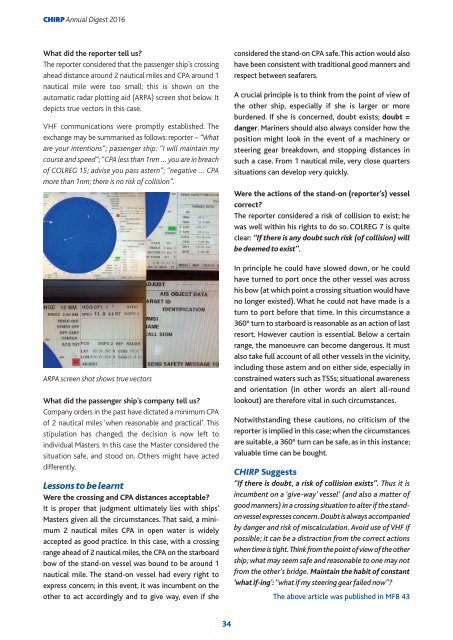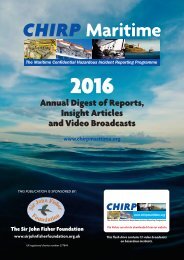CHIRP annual digest 2016 6th
Create successful ePaper yourself
Turn your PDF publications into a flip-book with our unique Google optimized e-Paper software.
<strong>CHIRP</strong> Annual Digest <strong>2016</strong><br />
What did the reporter tell us?<br />
The reporter considered that the passenger ship’s crossing<br />
ahead distance around 2 nautical miles and CPA around 1<br />
nautical mile were too small; this is shown on the<br />
automatic radar plotting aid (ARPA) screen shot below. It<br />
depicts true vectors in this case.<br />
VHF communications were promptly established. The<br />
exchange may be summarised as follows: reporter – “What<br />
are your intentions”; passenger ship: “I will maintain my<br />
course and speed”; “CPA less than 1nm … you are in breach<br />
of COLREG 15; advise you pass astern”; “negative … CPA<br />
more than 1nm; there is no risk of collision”.<br />
ARPA screen shot shows true vectors<br />
What did the passenger ship’s company tell us?<br />
Company orders in the past have dictated a minimum CPA<br />
of 2 nautical miles ‘when reasonable and practical’. This<br />
stipulation has changed; the decision is now left to<br />
individual Masters. In this case the Master considered the<br />
situation safe, and stood on. Others might have acted<br />
differently.<br />
Lessons to be learnt<br />
Were the crossing and CPA distances acceptable?<br />
It is proper that judgment ultimately lies with ships’<br />
Masters given all the circumstances. That said, a mini -<br />
mum 2 nautical miles CPA in open water is widely<br />
accepted as good practice. In this case, with a crossing<br />
range ahead of 2 nautical miles, the CPA on the starboard<br />
bow of the stand-on vessel was bound to be around 1<br />
nautical mile. The stand-on vessel had every right to<br />
express concern; in this event, it was incumbent on the<br />
other to act accordingly and to give way, even if she<br />
considered the stand-on CPA safe. This action would also<br />
have been consistent with traditional good manners and<br />
respect between seafarers.<br />
A crucial principle is to think from the point of view of<br />
the other ship, especially if she is larger or more<br />
burdened. If she is concerned, doubt exists; doubt =<br />
danger. Mariners should also always consider how the<br />
position might look in the event of a machinery or<br />
steering gear breakdown, and stopping distances in<br />
such a case. From 1 nautical mile, very close quarters<br />
situations can develop very quickly.<br />
Were the actions of the stand-on (reporter’s) vessel<br />
correct?<br />
The reporter considered a risk of collision to exist; he<br />
was well within his rights to do so. COLREG 7 is quite<br />
clear: “If there is any doubt such risk (of collision) will<br />
be deemed to exist”.<br />
In principle he could have slowed down, or he could<br />
have turned to port once the other vessel was across<br />
his bow (at which point a crossing situation would have<br />
no longer existed). What he could not have made is a<br />
turn to port before that time. In this circumstance a<br />
360° turn to starboard is reasonable as an action of last<br />
resort. However caution is essential. Below a certain<br />
range, the manoeuvre can become dangerous. It must<br />
also take full account of all other vessels in the vicinity,<br />
including those astern and on either side, especially in<br />
constrained waters such as TSSs; situational awareness<br />
and orientation (in other words an alert all-round<br />
lookout) are therefore vital in such circumstances.<br />
Notwithstanding these cautions, no criticism of the<br />
reporter is implied in this case; when the circumstances<br />
are suitable, a 360° turn can be safe, as in this instance;<br />
valuable time can be bought.<br />
<strong>CHIRP</strong> Suggests<br />
“If there is doubt, a risk of collision exists”. Thus it is<br />
incumbent on a ‘give-way’ vessel’ (and also a matter of<br />
good manners) in a crossing situation to alter if the standon<br />
vessel expresses concern. Doubt is always accompanied<br />
by danger and risk of miscalculation. Avoid use of VHF if<br />
possible; it can be a distraction from the correct actions<br />
when time is tight. Think from the point of view of the other<br />
ship; what may seem safe and reasonable to one may not<br />
from the other’s bridge. Maintain the habit of constant<br />
‘what if-ing’: “what if my steering gear failed now”?<br />
The above article was published in MFB 43<br />
34



